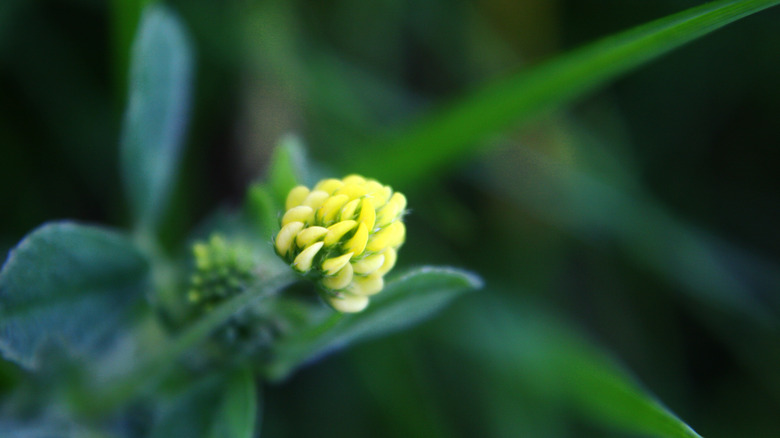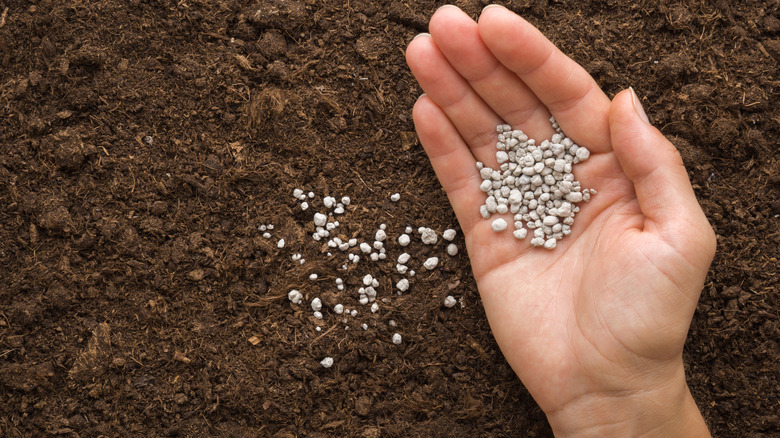What The Black Medic Weeds In Your Yard Are Trying To Tell You About Your Soil
Imagine clearing your schedule to spend quality time with family and reconnecting with nature, only to find five-petaled, buttery yellow flowers sunning on your verdant lawn. A deep dive into the annals of the internet has you matching the toothed side margins, spiky tips, and extended central stalk of the flowering plant's trifoliate foliage to black medic (Medicago lupulina), a weed notorious for taking over lawns, flower beds, and crop sites. But before you give in to despair, open a new tab, and start hunting for ways to eliminate black medic weeds from your lawn, step back and try to figure out what the weeds growing in your yard say about your soil. Spoiler alert: Your turf is running low on nitrogen.
Slyly entering a seed or forage mix in the late 1700s, black medic has since naturalized in several parts of the United States, to the extent of making it to the invasive list of a few state councils, including West Virginia. Although highly adaptive, black medic has a soft corner for fine-grained, slightly acidic, dry soils. Poor fertility levels and compaction officially lay out a welcome mat, especially in drought-prone areas.
Black medic weeds indicate dry soils, nitrogen deficiencies, and compaction
You may know black medic by one of its many other names — including hop medic, nonesuch, yellow trefoil, and black clover. This invasive plant can show up when you slack off on yard duty. Perhaps, you've been underwatering the turf to be more waterwise, leading to dry soil. Or, in your bid to turn your yard into a bird haven, you've allowed the grass to grow longer and limited your use of chemical-based fertilizers and pesticides. Unfortunately, when overdone, such practices invite undesirable growth — the black medic kind in particular.
Belonging to the tribe of leguminous plants, this white clover lookalike establishes mutually beneficial bonds with Rhizobium bacteria to make atmospheric nitrogen bio-available for plants. While this might be splendid for the surrounding vegetation, it isn't a good indicator of your soil's health because it implies a lack of appropriate nitrogen concentration. To boot, if you haven't aerated the lawn in a while, black medic weeds knead their way in through the densely packed soil particles. Eventually, the turfgrass loses the competition, leaving bare patches in its wake.
Follow the right cultural practices to improve the soil's condition
Although the fight against black medic weeds usually involves manual removal (hopefully, before they set seeds) or worse, herbicide control when things become unmanageable, an equally important approach is to hear out your soil and improve lawn management. This is because a healthy, dense, impeccably groomed turf can successfully ward off all weeds, and black clover is no exception. So, take the pesky invader's presence as a cue to get a soil test done — and repeat the practice every three years to check fertility levels. A balanced nitrogen fertilization schedule should get your grasses up and running (and greening!) in no time. Also, ensure the pH of your soil sits in the ideal range of 6.0 to 6.8.
To reduce compaction, core aerate your yard, enabling the grass roots to breathe better. This has the added advantage of improving water percolation levels and ensuring your deep, water-soaking sessions bear fruit by stimulating deeper root penetration. However, switch to spading forks for smaller lawns if you can't figure out whether you're renting the right kind of aerator for your yard. Follow up by overseeding the lawn to cover the exposed spots, lest weeds colonize the area. Simultaneously, ensure the grass seeds are appropriate for your site's conditions and of top-notch quality. Finally, mow your lawn to the right height, keeping the grasses between 2½ and 3½ inches.


